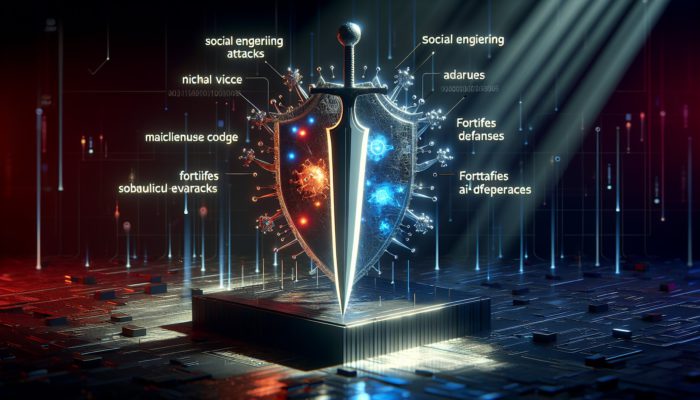Discover the CISO Experience: Navigating the Evolving Cybersecurity Landscape
Cybersecurity Insights: Welcome to the second episode of Series 3 of the CISO Experience, which is currently streaming live on the Infosec Live channel. This engaging series dives into authentic discussions with top security experts, focusing on technological innovations, human factors, challenges, and new opportunities that are reshaping the cybersecurity environment. Our sponsor, Simple Security, emphasizes that cybersecurity does not have to be overly complicated. They are dedicated to offering enterprise-level security solutions that are accessible, affordable, and effective for businesses of all sizes and sectors, ensuring that every organization can protect its digital assets.
Explore Adam Pilton’s Inspiring Transition from Law Enforcement to Cybersecurity Expert

Today, we are excited to welcome Adam Pilton, a passionate cybersecurity professional whose journey began in 2016. Adam’s path is both motivational and enlightening, starting in the field of cybercrime investigation and evolving into advisory roles. His distinctive viewpoint combines technical expertise with practical application, empowering him to translate complex risks into actionable strategies for business executives. This approach not only enhances their understanding of cybersecurity protocols and practices but also equips them to make informed decisions that bolster their organization’s security posture.
Valuable Lessons Learned from Adam’s Early Law Enforcement Career
Adam commenced his professional journey as a police officer, dedicating 15 impactful years in this role. He led the covert operations unit, which consisted of three specialized teams: the Covert Authorities Bureau, Communications Data Investigators, and the Cybercrime Team. His responsibilities included securing lawful authorities for covert operations while addressing issues that spanned both physical and digital landscapes. This multifaceted experience has shaped his understanding of the intricate relationship between traditional law enforcement and modern cybersecurity challenges.
One of the most profound lessons Adam gained from his early experiences was the significant human impact of cyber threats. He interacted with victims, both individuals and organizations, and witnessed firsthand the devastating consequences of cybercrime. For instance, while losing access to a Facebook account might seem trivial at first glance, if it holds irreplaceable memories such as photographs of loved ones, the emotional ramifications can be profound and long-lasting, highlighting the need for effective cybersecurity measures.
Strategically Transitioning from Law Enforcement to the Private Sector
After 15 fulfilling years in law enforcement, Adam realized that he had reached the pinnacle of his career within the police force. The limited opportunities to expand his team’s digital capabilities, coupled with the allure of more frontline roles, compelled him to make the significant decision to leave the police service. He subsequently joined Heimdal Security, drawn by their high-quality products and the opportunity to continue his impactful work in the field of cybersecurity. This transition has allowed him to leverage his experience to help organizations navigate the complexities of digital security.
Identifying Cybersecurity Challenges and Motivating Proactive Security Measures

Adam argues that the cybersecurity sector is facing a significant motivation dilemma. Despite constant media coverage highlighting various cyber threats, many organizations recognize the necessity for immediate action yet find it daunting to implement effective solutions. The overwhelming complexity associated with cybersecurity often leaves companies unsure about where to start their improvement journey, resulting in a reactive rather than proactive approach to securing their digital environments.
To address this issue, Adam advocates for the adoption of frameworks like Cyber Essentials in the UK. These structured frameworks provide a clear roadmap for organizations, enabling them to strengthen their cybersecurity measures while systematically enhancing their capabilities. A recent study revealed that 60% of individuals who complete the Cyber Essentials program gain new insights with each attempt, underscoring the critical importance of ongoing education and development in this rapidly evolving field.
The Crucial Role of Law Enforcement and Government in Cybersecurity Support
Adam acknowledges that law enforcement agencies and government organizations play an essential role in assisting businesses with their cybersecurity requirements. However, he also emphasizes the need for the industry to improve its approach to providing meaningful assistance. The outdated strategies of fear, uncertainty, and doubt commonly employed to market cybersecurity solutions are no longer effective; businesses now require more practical, actionable guidance and support to navigate the complexities of today’s threat landscape.
Recognizing Emerging Threats and Key Trends in Cybercrime
The landscape of cyber threats has changed dramatically over the last decade, with attackers consistently staying several steps ahead of organizations. A notable trend is the resurgence of social engineering attacks, exemplified by groups such as Scattered Spider. These sophisticated attacks frequently target IT help desks, employing advanced methods that are often backed by <a href="https://limitsofstrategy.com/artificial-intelligence-ai-when-a-real-human-is-needed/">artificial intelligence</a>. This evolution necessitates a more vigilant approach to cybersecurity for organizations.
Adam further highlights the shift in the dynamics of cybercrime, transitioning from solitary hackers to highly organized crime syndicates. These groups function with the structure of legitimate businesses, complete with dedicated customer service teams. For instance, platforms offering ransomware-as-a-service now provide legal counsel to assist in ransom negotiations, illustrating the alarming sophistication and professionalism of modern cybercrime. This heightened organization poses new challenges for businesses striving to protect their assets.
Utilizing AI’s Dual Role to Enhance Cybersecurity Measures

artificial intelligence serves as a double-edged sword in the realm of cybersecurity. While it has the potential to enhance the effectiveness of social engineering attacks, it also offers valuable opportunities for defense and fortification. Adam believes that AI will play a pivotal role in empowering businesses to establish more secure environments; however, it will also introduce new challenges that organizations must proactively address to stay ahead of cybercriminals.
Fostering a Security-Conscious Culture within Organizations
Establishing a culture of security awareness is imperative for a robust cybersecurity strategy. Adam underscores the importance of integrating security principles into the very fabric of an organization’s culture, beginning with the formulation of clear mission and vision statements that reflect security as a priority. This holistic approach ensures that every employee recognizes their essential role in maintaining security within the organization and feels empowered to contribute to its overall safety.
To effectively engage employees, Adam advocates for making training relatable to their daily experiences. For instance, illustrating the repercussions of losing personal data, such as cherished photographs, on a social media platform can greatly enhance their understanding of the importance of cybersecurity in a practical and meaningful manner. This connection between personal experiences and organizational security can motivate employees to take cybersecurity seriously.
Adopting Frameworks for Cybersecurity Maturity and Continuous Development
For organizations embarking on their cybersecurity journey, Adam strongly recommends the implementation of structured frameworks such as Cyber Essentials. These frameworks provide a clear, systematic approach to establishing security measures, thereby assisting businesses in avoiding feelings of overwhelm while building a resilient foundation. By following these guidelines, organizations can ensure they are taking the necessary steps to protect their digital assets effectively.
He also stresses the critical importance of continuous improvement, as cybersecurity is an ongoing process rather than a one-time initiative. Organizations must consistently adapt and evolve their security posture to meet the ever-changing threat landscape and the dynamic environments in which they operate. This commitment to growth is essential for maintaining a robust defense against cyber threats.
Anticipating the Future of Cybersecurity: Opportunities and Challenges Ahead
Adam expresses optimism regarding the growing public awareness of cybersecurity. As younger generations become increasingly familiar with technology, they bring a heightened understanding of cybersecurity principles into their workplaces. This shift in awareness has the potential to significantly aid businesses in cultivating more resilient security cultures, ultimately leading to more effective protection against cyber threats.
Additionally, Adam identifies promising opportunities in artificial intelligence that could enable businesses to automate and enhance their security measures. However, he cautions that the rise of AI also introduces new challenges that organizations must be prepared to confront, emphasizing the need for proactive strategies to mitigate potential risks associated with AI implementations in cybersecurity.
Preparing the Next Generation through Comprehensive Cybersecurity Education
Adam asserts that a greater emphasis must be placed on educating children about cybersecurity principles. Although educational institutions currently employ varied approaches to teaching these concepts, a more standardized curriculum could better prepare the next generation for the complexities of the digital landscape. This foundational education is crucial in equipping young people with the knowledge they need to navigate the online world safely.
Moreover, parents play a crucial role in teaching their children about online safety. Adam suggests establishing clear boundaries regarding device usage and educating children about the risks associated with sharing personal information online. By fostering open conversations about cybersecurity at home, parents can empower their children to make informed decisions in their digital interactions.
Key Takeaways from Adam Pilton’s Journey: Navigating Cybersecurity Challenges
Adam Pilton’s remarkable journey from police officer to cybersecurity professional provides invaluable insights into the significant human impact of cyber threats and the urgent need for pragmatic, actionable security measures. As businesses navigate the intricate realm of cybersecurity, structured frameworks such as Cyber Essentials can serve as a solid foundation for developing a resilient security posture, ensuring that organizations are prepared to face evolving threats.
The future of cybersecurity is filled with potential, characterized by heightened awareness and the transformative power of AI to strengthen security measures. Nevertheless, this evolving landscape also presents new challenges that businesses must proactively address. By prioritizing security awareness, fostering an inclusive culture, and committing to continuous improvement, organizations can effectively stay ahead of emerging threats and protect their most valuable assets.
The post Cybersecurity Insights: From Police to CISO appeared first on Ezi Gold.
The Article Cybersecurity Insights: Transitioning from Police to CISO Was Found On https://limitsofstrategy.com
